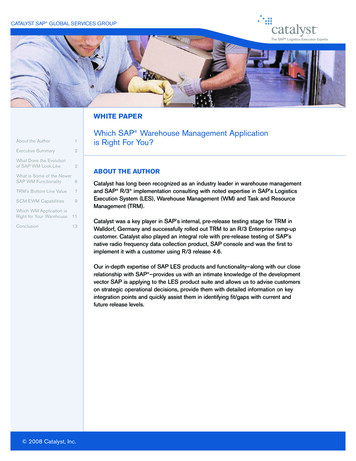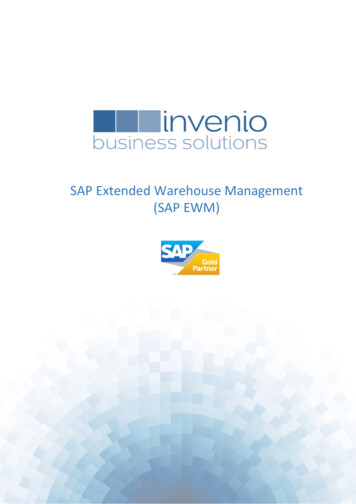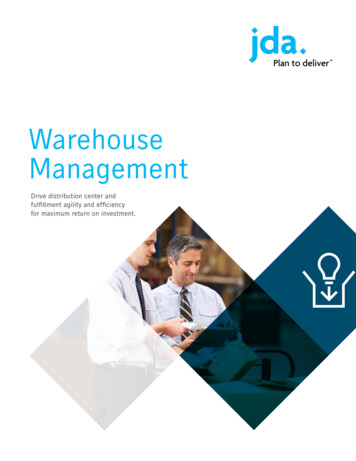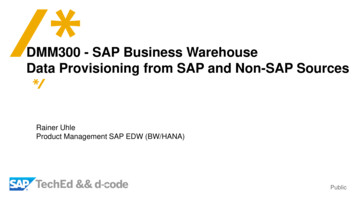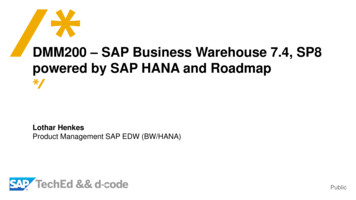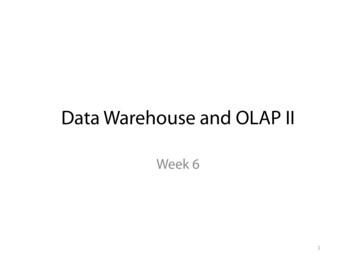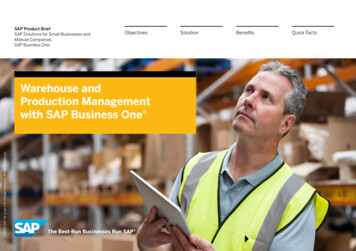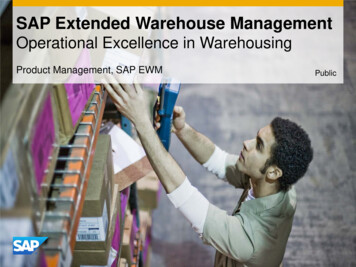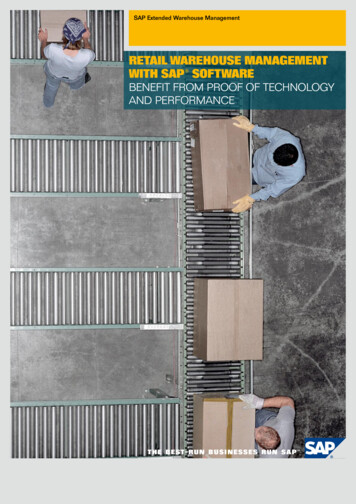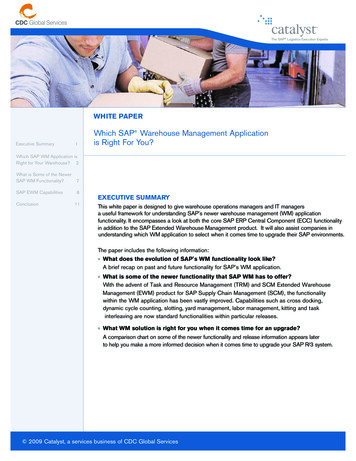
Transcription
WHITE PAPERExecutive Summary1Which SAP Warehouse Management Applicationis Right For You?Which SAP WM Application isRight for Your Warehouse? 2What is Some of the NewerSAP WM Functionality?7SAP EWM Capabilities8Conclusion11EXECUTIVE SUMMARYThis white paper is designed to give warehouse operations managers and IT managersa useful framework for understanding SAP’s newer warehouse management (WM) applicationfunctionality. It encompasses a look at both the core SAP ERP Central Component (ECC) functionalityin addition to the SAP Extended Warehouse Management product. It will also assist companies inunderstanding which WM application to select when it comes time to upgrade their SAP environments.The paper includes the following information: What does the evolution of SAP' s WM functionality look like?A brief recap on past and future functionality for SAP’s WM application. What is some of the newer functionality that SAP WM has to offer?With the advent of Task and Resource Management (TRM) and SCM Extended WarehouseManagement (EWM) product for SAP Supply Chain Management (SCM), the functionalitywithin the WM application has been vastly improved. Capabilities such as cross docking,dynamic cycle counting, slotting, yard management, labor management, kitting and taskinterleaving are now standard functionalities within particular releases.What WM solution is right for you when it comes time for an upgrade?A comparison chart on some of the newer functionality and release information appears laterto help you make a more informed decision when it comes time to upgrade your SAP R/3 system. 2009 Catalyst, a services business of CDC Global Services
WHICH WM APPLICATION IS RIGHT FOR YOUR WAREHOUSE?SAP EWM and the TRM capabilities in SAP ERP 4.7 are tailored to be of most benefit to thewarehouse with high activity levels, high volume and complex operations. These and other factorsshould be considered when determining which application is a fit for your facility.Warehouse operations with a high level of distribution activity, volume, operationalcomplexity and value added services are the best fit for SAP EWM and TRM.It is important to note that all future enhancements and new functionality will continue.to move in the direction of SAP EWM. This statement is not intended to raise questionsaround support; SAP will continue to support the core WM module along with TRM. It isonly meant to point out the direction of the new functionality.High Level of Distribution Activity & Materials MovementSAP EWM and TRM were designed to benefit warehouse operations that aremore distribution oriented as opposed to material storage oriented (e.g., aproduction supply facility). If efficient management, movement and distribution ofmaterials are core competencies and critical success factors for your organization,EWM is a good fit and will significantly enhance your labor efficiencies and minimizeyour labor costs. The monitoring capabilities provide increased visibility into movementand material throughout the warehouse, as well as those inbound and outbound. Catalystprovides specific enhancements that can even integrate Small Package Shipping serviceswith FedEx, UPS and other carriers, including LTL.High Level of VolumeTRM and SAP EWM offer the most value to those facilities with a high level ofmaterial flow velocity (typically characterized by the number of transfer orders or lineitems), high transaction volume, a high number of warehouse associates per shiftand multiple types of material handling equipment. The higher the number, thebetter the fit. For example, if you have 50 trailer loads a day, you will reap a muchhigher benefit from the system than if you only have five.Operational ComplexitySAP EWM and TRM offers strong functionality for complex material flows, such asthe use of special equipment that cannot physically make certain material movesefficiently, but instead uses pick and drop locations. The system’s decomposition ofTOs into tasks offers an advantage for these complex scenarios. Other operationalcomplexities such as pallet decomposition and other warehouse work centeroperations are handled much better in SAP EWM and TRM.Level of Value Added ServicesTRM and SAP EWM also offer strong functionality for value-added services suchas special labeling, pricing, packaging, and hazardous materials notes on shippingdocuments. The higher the level of services you offer, the better the fit with thesesolutions. Many pharmaceutical organizations require additional quality checks on random,product or origin parameters and this functionality can be leveraged effectively for this purpose.2
Current User of SAP WM and DecentralizationCurrent users of SAP WM will find an independent systems configurationaudit and warehouse operational review beneficial prior to undertaking theimplementation of TRM or SAP EWM. It is highly recommended that usersconsidering these solutions as part of the initial WM rollout seek experiencedconsulting support because of the complexity and abstraction of these solutions.Other factors that should be weighed when considering the implementation of TRMor SCM EWM is the organization’s ability to decentralize the WM/TRM/SAP EWMsystem as well as the use of Storage Units (SUs) or Handling Units (HUs).The decentralized WM architecture is strongly recommended for TRM and isassumed for those who want SAP EWM because of the heavy processor load thatTRM and SAP EWM can pose for your core system. HUs or SUs work verysmoothly with TRM and make task processing more efficient. HUs are necessarywhen considering SAP EWM. Implementing decentralized WM and choosingwhether or not to use HUs or SUs should be considered a prerequisite to implementingTRM. Companies with more than one Distribution Center, geographically separated, canalso benefit from a decentralized architecture. If the connection from the central SAP ERPinstance broken, S EWM can continue to operate as normally, working on the Inbound andOutbound Deliveries already sent down to EWM. Once the connection is restored, the interfacewill synchronize the two systems. This also allows for maintenance on the ERP system withoutimpacting all Distribution Centers.3
SAP Releases by DateR/21990’s.WM was a sub-module within the R/2 systemSAP R/3Version 3.1. 1998Version 4.0B.1998Version 4.5B.1999Version 4.6B. 2000Version 4.6C. 2000Version 4.7 xt. 1.1.2002Version 4.7 xt. 2.0.2003mySAP ERP 2004 (ECC 5.0). 2005mySAP ERP 2005 (ECC 6.0). 2006mySAP SCM EWM 5.0. 2005mySAP SCM EWM 5.1. 2007mySAP SCM EWM 7.0. 2008SAP's WM 3.X functionalityincluded the following: Storage and Facility Management –manage different batches, stock types(vendor consignment stock, own), andstock status (quality, unrestricted) Warehouse Structure – basic buildingblocks of the warehouse (storagetype, storage sections and bins) Stock Management – mixed andhomogeneous storage possible Material Master Data – addition ofWM fields in MM views Units of Measure – WM unit possibleat WM level SLED Posting Changes – material tomaterial, stock status to stock status Transfer Requirements/TransferOrders Ability to Post Stock Differences –upon putaway only Fixed Bin Replenishment Putaway Strategies Picking Strategies Storage Unit Management HAZMAT Inbound Material Processing Internal MovementsOutbound Material ProcessingPhysical Inventory Annual Continuous Cycle Count Zero Stock CheckBasic ReportingAuthorizationsArchivingInterfaces Available to ExternalSystems (i.e. RF devices)User Exits AvailableSAP's WM 4.0 functionalityincluded the following: Lean WM New org. structures such as gates,picked items zone, and pick area Capacity to search up to 30 StorageTypes (previously 10) Number of Storage Unit Typesincreased to 30 (previously 10) Number of Storage Sections searchedincreased to 30 (previously 10) Up to 99 items can be managed in abin with Putaway strategy P(previously 14)4
More than 1 storage location can bewarehouse managed under the samewarehouse number (previously only 1warehouse per storage location andplant was manageable).Pick strategy performance enhanced(active capacity check)WM unit of measure possible atmaterial levelEnhanced stock search (i.e cansearch own stock before vendorconsignment stock)Enhanced storage section searchcapabilityCreate Transfer Order (TO) for GRfrom Return Stock functionalityCustomer Exit available forReplenishmentsPlanned TO times – used for thebasis of workload calculation andincentive wageTO Splitting – balance workloadbetween usersAbility to change a TRAbility to process posting changescompletely in WMEnhanced putaway strategy K and Bulkputaway (ability to block from furtherstock placements to ensure FIFO)Ability to process QM samples in thebackground2 Step PickingEnhanced strategy M through roundingquantities on the material master calls a customer exit forStringent FIFOPre-picked shipping unitsFree PackingPlanning and Monitoring ToolsPicking WavesRough Workload Estimator WAM (warehouse activity monitor)Physical Inventory Changes – monetarylimits can be set for recountsQuantity reductionDisplay material texts with ReleaseOrder Parts StagingSAP's WM 4.5A functionalityincluded the following: New component added (LES) vs. WM dWM (Decentralized WarehouseManagement) available KANBAN capabilities Destination bin changeable uponputaway TO confirmation Ability to close out TR’s (i.e. setdelivery complete) TO processing comment added Basic pre-allocated stock crossdocking (hot list) Inbound delivery becomes available Ability to putaway stock that wasincorrectly picked on a delivery Enhanced picking reports Enhanced HAZMAT processing Physical inventory enhanced –inspection lot processingSAP's WM 4.6 A/B functionalityincluded the following: Ability to suppress differences inconfirming TO’s Two-step TO confirmation possible Native RF capabilities RF Monitor available Enhanced dWM capabilities Use of Enjoy transactions (LS01 toLS01N) make transactions easier to use Reports converted to ABAP ListViewer (ALV) – gives the user theability to sort, sum, etc.5
SAP's WM 4.6C functionalityincluded the following: Added additional SAP console (RF)transactions and fixed many bugs Ability to create a replenishment TOautomatically Handling Unit Functionality Physical Inventory Changes –counting at quant level possible Basic interleaving possible Enhancements to dWM – postingchanges initiated from dWM, deliverysplit Proof of Delivery functionality Packing StationSAP's WM 4.7 functionalityEE1 included the following: 1 TO possible for multiple deliveries Partial GR for an IBDN possible TRM (Task and ResourceManagement) introduced Data changes to dWM can be timed Several ERP systems can be tied toa single dWM instanceSAP's WM 4.7 EE2 functionalityincluded the following: Support for DSD (Direct StoreDelivery) Planned and Opportunistic CrossDocking functionality Value Added Services Yard Management Dynamic Cycle Counting TRM enhancements (Log monitor,capacity checks at the node level) RF serial number capture possible onthe DeliveryFunctionality built within mySAP E R P2004 (ECC 5.0) or mySAP E R P 2005(ECC 6.0) includes the following: Advanced Transportation Planning (ATP)and Vehicle Scheduling using APO Direct Store Delivery enhancements Archiving enhancements Progress Confirmation of jobs(background status update every 30min, foreground every 10 seconds) WCU (Warehouse Control Unit) –controls automation of warehousedevices; optimized when used inconjunction with TRMFunctionality built within SAP EWM 5.0for SAP SCM includes the following:SlottingRearrangement Warehouse Orders Warehouse Monitor Internal Routing Value Added Services Quality Inspection Engine Yard Management Transportation Cross-Docking Tight EH&S Integration Kit to Order - Requires CRM Resource Management Functionality built within SAP EWM 5.1for SAP SCM includes the following :Labor ManagementRFID Enablement - Integration with All Warehouse Cockpit Batch Management Enhancements Serial Number Enhancement – can track SNt o a bin without needing an HU Production Receiving Catch Weight Material Flow Systems Functionality built within SAP EWM 7.0for SAP SCM includes the following : Merchandise Distribution Cross-Docking Opportunistic Cross-Docking Production Supply Graphical Warehouse Layout Task Interleaving6
WHAT IS SOME OF THE NEWER WM FUNCTIONALITY FROM SAP?TRM offers uniquefeatures for optimizedmaterials movement, atransparent view ofwarehouse processesand value addedservices support.With TRM’s support forvalue added services,you can easily labelgoods or accommodatecustomers’ specialpackaging requests.WM and TRM Functionality in SAPAs of SAP release 4.7, TRM strengthens and completes the LES/WM solution byoptimizing material flows via task execution and resource deployment. TRM breaksdown material movements to a task and resource level and optimizes the sequencein which they are executed, ensuring that the right task is completed by the bestresource at the most optimal time.TRM helps you to manage your warehouse processes more efficiently because itachieves an unparalleled degree of process visibility within the system by trackingany activity performed on the warehouse floor. TRM uses a systemic model of thewarehouse’s physical layout to deploy resources according to the actual workload,the resource’s qualifications and the current geographic positions of the resources.The efficient deployment of resources contributes to a considerable reduction ofcosts in material flow processing.TR
SAP EWM and the TRM capabilities in SAP ERP 4.7 are tailored to be of most benefit to the warehouse with high activity levels, high volume and complex operations. These and other factors TRM and SAP EWM also offer strong functionality for value-added services such. Current User of SAP WM and Decentralization Current users of SAP WM will find an independent systems configuration audit and .
